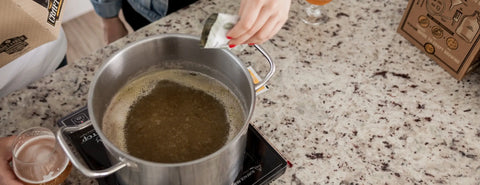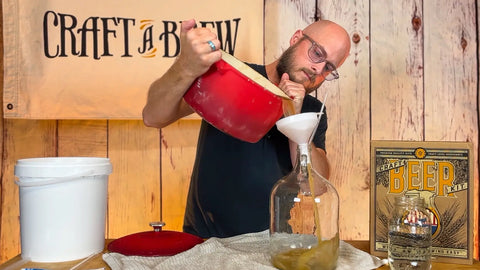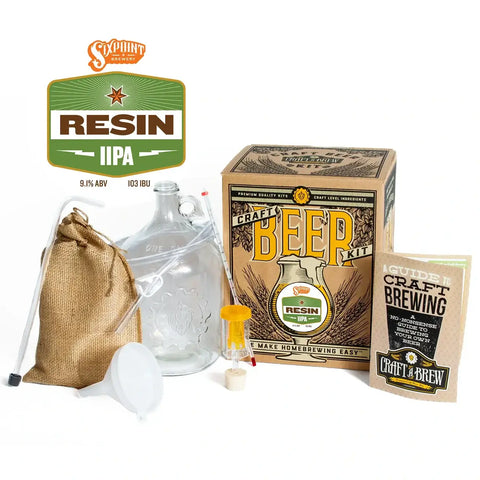How to Brew Double IPA
TL;DR: Curious about how to brew Double IPA at home? This bold, hop-forward style is known for its intense bitterness, elevated alcohol content, and resinous, citrus-packed aroma. If you've ever asked, "How can I make IPA that's big and bold?" or "How do you make IPA that packs a punch?", you’re in the right place.
To brew your own Double IPA, you’ll need the right IPA ingredients—massive hop additions for bitterness and aroma, a solid malt backbone to balance the high ABV, and a clean, high-attenuation yeast strain. The Double IPA brewing process also involves precise hop timing, fermentation temperature control, and oxygen management to maintain a crisp, fresh hop character.
With Craft a Brew’s Sixpoint Resin IIPA Beer Recipe Kits, available in 1-gallon and 5-gallon sizes, brewing Double IPA at home has never been easier. Our kits include all the essential ingredients, plus step-by-step instructions to guide you through the home Double IPA brewing process. Whether you're an experienced homebrewer or just learning how to brew your own Double IPA, this guide will walk you through everything from brew day to bottling.
- Overview
- Download The Guide
- What You’ll Need to Make IPA
- Step-by-Step IPA Recipe
- Watch the Video
- Troubleshooting & Tips
- Customize Your IPA
Getting Started with Brewing a Double IPA
Are you a self proclaimed hop head? Do you love a Double IPA? Why not brew one yourself! If you've ever wondered, "How can I make IPA with intense hop character and a higher ABV?" then a Double IPA (or Imperial IPA) is the perfect style to explore. Double IPAs are bigger, bolder, and hoppier than standard IPAs, featuring an elevated ABV (7.5% - 10%) and higher International Bitterness Units (IBUs), which provide that signature crisp, lingering hop bite. How do you make IPAs that pack a hop bite and elevated ABV? Read on!
This style was born in the American craft beer movement of the late 1990s, when brewers started pushing the envelope on hop intensity to satisfy IPA lovers craving even bolder flavors. Today, brewing Double IPA at home allows you to experiment with different hop combinations while fine-tuning balance, bitterness, and drinkability.
The key to brewing Double IPA at home is achieving this balance: a strong malt backbone that supports the aggressive hopping without making the beer overly sweet or heavy. If you want to know how to brew Double IPAs that impress, look to the BJCP (Beer Judge Certification Program) definition of a Double IPA:
- Appearance – Golden to deep orange-copper with good clarity and a moderate white to off-white head.
- Aroma – Intense hop aroma featuring citrus, pine, resin, tropical fruit, and floral notes. Dry-hopped versions may have an extra layer of fresh, grassy hop character.
- Flavor – Strong hop-forward flavor with high bitterness, balanced by a clean, grainy malt backbone. Low residual sweetness, with a dry to medium-dry finish.
- Mouthfeel – Medium-light to medium body, smooth texture, and moderate to high carbonation. A light alcohol warmth is acceptable but should never be harsh.
- Drinkability – Despite the high ABV, a good Double IPA should remain crisp, clean, and dangerously drinkable—not overly sweet, cloying, or heavy.
A great way to brew your own Double IPA is with Craft a Brew’s Sixpoint Resin IIPA Beer Kit. This Imperial IPA is inspired by Sixpoint Brewery’s Resin IIPA, a beer known for its bold, resinous hop character and a 9.1% ABV punch. Our kit includes a massive dose of American and New World hops, which provide layers of pine, citrus, and floral aromas, along with a fermentable sugar boost to ensure a dry, drinkable finish. Whether you’re an experienced brewer or just learning how to brew Double IPA at home, this kit takes the guesswork out of the process, delivering a high-quality, hop-forward beer that’s worthy of any craft beer enthusiast.
Download Our Guide to Making IPA
For complete step by step instructions on how to double IPA (DIPA or IIPA), download our instruction guide to making IPA & other ales at home. This beginner friendly manual accompanies will walk you through brew day, fermentation and bottling!
What You’ll Need To Make IPA
The key to brewing Double IPA at home is selecting the right IPA ingredients, using proper equipment, and mastering the Double IPA brewing process. Whether you're crafting a 1-gallon batch for small-scale experimentation or stepping up to a 5-gallon recipe kit, having the right tools and ingredients will ensure a smooth brewing experience and a hop-packed final beer.
Ingredients
To brew the best Double IPA, start with the right IPA ingredients. A Double IPA uses a solid malt base to support aggressive hopping. To achieve a resinous, piney, citrus-forward profile, you need high-quality hops, a strong malt backbone, and clean-fermenting yeast.A Double IPA starts with enough fermentable sugars to reach a higher ABV (alcohol by volume), usually 7.5% - 10% ABV. You need to strike a balance between achieving the proper ABV, while maintaining balance with the intense hop profile. Choose clean malts that can support aggressive hopping without overshadowing the hops. Our Sixpoint Resin IIPA uses a Pilsen Dry Malt Extract base for neutral fermentable sugars. It also employs additional specialty grains, which are used in beers to add color, mouthfeel, body, flavor and aroma to a malt base. Our Sixpoint Resin Double IPA Kit uses Carapils for foam stability and head retention and Flaked Barley for a smoother mouthfeel. Flaked Barley is a great way to add back some heft to the body of the beer, especially if using additional fermentable sugars to reach a high ABV (such as Corn Sugar). High ABV beers have a tendency to ferment out pretty dry or thin, so using a body-boosting specialty grain can help combat this.
To achieve higher alcohol content, you may need to supplement your beer with added fermentable sugars. Corn Sugar (Dextrose) is an excellent option for adding clean, neutral sugars for yeast to convert into alcohol. Note: using excessive volumes of fermentable sugars can lead to a thinning or drying of the finished beer.
Hops might be the most important Double IPA ingredients - they make the style. The goal is a layered and prominent hop bitterness and hop character through and through. Use hops with high Alpha Acids (high bitterness potential) at the beginning of the boil. The longer they are in the boil the more bitterness they’ll release into the wort (unfermented beer). It’s important to support the bitterness with late addition hops and dry hops. Hops added later in the process will release more flavor and aroma into the beer (rather than intense bitterness). Using a combination of hop varieties, rather than a single type, and using them at different points of the brew process helps create a complex double IPA. We suggest hops that are bright, citrusy, even lightly floral, for a well rounded Double IPA. Think Simcoe, Mosaic, Cascade and Centennial
Our Sixpoint Resin IIPA uses SafAle US-05 dry ale yeast. This strain is excellent for making American ales and IPAs because of its neutral, clean finish. It helps promote a foamy head in your glass and provides a crisp, clean palate. Dry yeasts are excellent choices for homebrewing Double IPAs because they’re shelf stable and don’t require refrigeration like liquid yeasts.
Equipment
To brew your own Double IPA you’ll use the same essential equipment you’d use to brew any other ale! New to homebrewing? Our 1 gallon Sixpoint Resin Double IPA making kit has everything you need to get started!You’ll need a stock pot that can fit as close to a full gallon of liquid as possible. You’ll need a few inches of room to prevent boil overs. Don’t use too large a pot - this can increase evaporation rates and result in volume loss. Your pot should have a lid, which is used when chilling the beer before pitching the yeast.
It’s important to closely monitor and maintain temperatures at different points in the brewing process. Our Sixpoint Resin Double IPA making kit includes a glass lab thermometer, but you can use any food-safe thermometer, like a digital thermometer! Key temperatures your thermometer must reach are 155ºF and 75ºF.
A funnel helps you transfer the wort (unfermented beer) from your stock pot into the carboy. A 4” funnel is included in our Double IPA making kit.
A 1 gallon carboy is where yeast turns the wort (unfermented beer) into an IPA. A rubber stopper plugs the neck to maintain a proper seal. A carboy is included in our Double IPA making kit.
A racking cane is a rigid plastic tube that is submerged into your beer to start a siphon transfer. Siphons reduce oxidation and help lift your fermented beer up off of sediment and into bottles. A racking cane is included in our Double IPA making kit.
After fermentation, you’ll need to carbonate your beer in bottles. You can use flip top bottles, like Grolsch style bottles, or you can use pry-off beer bottles, caps and a capper tool. You’ll need roughly ten 12oz bottles per gallon of beer. That’s about eight 16oz bottles per gallon or four 32oz bottles per gallon.
When working with high volumes of hops, a nylon hop straining bag is highly recommended on brew day. Keeping hop sediment contained helps improve the overall clarity in your Double IPA. Keeping hop matter out of the fermenter and out of your bottles improves the overall flavor of your IPA.
Step-by-Step Brewing Guide
Brewing Double IPAs at home is as easy as brewing any other ale! This step-by-step guide will show you how to brew your own Double IPA, from sanitizing your equipment to fermenting and bottling your beer. Follow along and learn how to brew Double IPAs at home with confidence.Step 1: Sanitize Everything
Before you begin brewing, proper sanitation is critical. Any bacteria or wild yeast can ruin your beer. Mix half of the included sanitizer packet with 1 gallon of water in a bucket or pitcher. Submerge all equipment that will touch the beer after boiling (fermenter, funnel, airlock, tubing, thermometer). Let everything soak for at least 60 seconds. No need to rinse—just let the sanitized equipment air dry on clean paper towels.
Step 2: Heating the Water & Steeping the Grains
Pour as close to a gallon of water as possible into your brew pot while leaving a few inches of space to prevent boil-overs.
Heat the water on high heat until it reaches 155°F (68°C).
Place the specialty grains into the grain steeping bag, tie it off, and steep in the water for 20 minutes.
Remove the grain bag and discard—do NOT squeeze it, as this can release tannins and create unwanted bitterness.
Step 3: Boiling & Adding Malt Extract
Increase the heat and bring the wort (unfermented beer) to a boil.
Once the first bubbles appear, remove the pot from heat and slowly stir in the dry malt extract to prevent clumping. Add Corn Sugar (Dextrose) now, if using.
Step 4: Adding Hops
Return the pot to medium-high heat to maintain a gentle rolling boil. Set a 60 minute timer. Hops will be added throughout the process to add a layered & complex hop profile:
- At the start of the 60-minute boil, add Bittering Hops.
- At 25 minutes left in the boil, add Late Bittering Hops.
- At 10 minutes left, add Flavor Hops.
- At the very end of the boil, just before removing the pot from heat, add the Flameout hops.
Pro Tip: Watch for boil-overs! If your wort foams up, turn off the heat and stir to prevent spills.
Step 5: Cooling the Wort
After boiling, the wort must be cooled to a yeast-friendly temperature before fermentation can begin.
Create an ice bath in your sink using ice and cold water.
Place the pot in the ice bath and cover it with a lid to avoid contamination.
Stir the surrounding ice water occasionally to speed up the cooling process.
Use a sanitized thermometer to check that the wort is below 75°F (23°C).
Step 6: Transferring to the Fermenter & Pitching Yeast
Using a sanitized funnel, transfer the cooled wort into the sanitized fermenter, leaving any thick sediment (trub) behind.
If needed, add cool water to reach the "one-gallon" fill line.
Cut open the yeast packet and pitch the yeast (sprinkle the entire contents into the fermenter).
Aerate the wort by sealing the fermenter and shaking it vigorously for one minute. This helps the yeast thrive.
Step 7: Setting Up the Blow-Off Tube & Monitoring Fermentation
Insert a sanitized blow-off tube into the fermenter’s rubber stopper. Place the other end in a half-full glass of water. This prevents foam overflow.
Place the fermenter in a dark, temperature-stable location (ideally 60-75°F).
Within 24-48 hours, you should see bubbling activity as fermentation begins.
Step 8: Swapping the Blow-Off Tube for an Airlock
After 4-5 days, once bubbling slows down, swap the blow-off tube for an airlock filled with water.
Fermentation will continue for about 10-14 days.
Step 9: Preparing Bottling Equipment & Priming Sugar
Sanitize bottles, caps, siphon tubing, and the bottling wand.
In a stockpot, heat 1.5 cups of water with 2 Tablespoons of sugar. Stir until dissolved and boil for 5 minutes.
Allow the sugar water (priming sugar) to completely cool before using.
Step 10: Siphoning Beer into Bottles
Place the fermenter on a high surface and the pot of priming sugar on the floor.
Siphon the beer into the pot, carefully leaving sediment behind.
Gently stir the beer to evenly mix in the priming sugar.
Using sanitized tubing, siphon the beer into bottles, filling just to the neck. Cap the bottles.
Step 11: Carbonation & Aging
Store bottles in a dark, temperature-controlled area (68-75°F) for two weeks to allow carbonation to develop.
After 14 days, refrigerate and enjoy your homebrewed Double IPA!
Pro Tip: If your beer is under-carbonated, let it sit at room temperature for an additional 3-5 days before chilling.
Common Brewing Mistakes to Avoid
Brewing a Double IPA comes with unique challenges due to its high hop content, elevated alcohol levels, and complex balance of flavors. We’ll cover some of the common mistakes brewers make when brewing Double IPA and how to avoid them. Lucky for you, Craft a Brew’s home brew kits include carefully selected ingredients and user-friendly instructions to help you avoid these mistakes!✅ How to Avoid It: When transferring beer, use always use a siphon to minimize splashing. Whenever adding hops to your fermenter, work quickly to reduce oxygen exposure time.
✅ How to Avoid It: Focus on late hop additions and dry hopping to enhance aroma and flavor without excessive bitterness. Consider using a calculated approach to IBU (International Bitterness Units) to maintain balance.
Leaving too much hop material in your fermenter or bottles can lead to several issues:
- Cloudy beer with excessive hop debris
- Grassy, vegetal off-flavors from prolonged contact with hop matter
- Siphon clogs during transfers
- Sediment-heavy bottles that result in unwanted hop floaters in your glass
✅ How to Avoid It: Use a hop bag or mesh strainer when adding hops during the boil to contain hop particles. If adding loose hops, allow time for them to settle before transferring to the fermenter. For dry hopping, consider using a sanitized hop sack or stainless steel hop basket to keep hop matter contained while still extracting maximum aroma and flavor. When siphoning, leave behind as much hop sediment as possible and avoid disturbing the trub at the bottom of your fermenter.
✅ How to Avoid It: Use malt-derived fermentables like extra pale malt extract, Munich malt, or light crystal malt to retain some body and balance. Consider selecting specialty grains that provide body to offset added sugars. Consider using maltodextrin, a mostly non-fermentable sugar that helps boost mouthfeel and body without thinning.
Tips for Successful Homebrewing
Brewing a bold, hop-forward Double IPA at home is easier than you think—especially with Craft a Brew’s Sixpoint Resin IIPA Beer Recipe Kit! This kit provides everything you need to brew your own Double IPA with a massive hop punch and a smooth, resinous finish. Whether you're brewing for the first time or fine-tuning your Double IPA brewing process, these pro tips will help you get the best results.Water plays a crucial role in balancing a Double IPA’s intense hop character and smooth malt backbone. The wrong water profile can lead to muted hop flavors or excessive bitterness.
- Use filtered or spring water for a clean base. Avoid using distilled water, which is stripped of natural minerals that are important for fermentation.
- Adjust with gypsum (calcium sulfate) to enhance hop perception and calcium chloride to round out the malt.
A Double IPA has a higher alcohol content (often 8-10% ABV), meaning yeast has a lot more work to do. Poor yeast health can lead to incomplete fermentation, off-flavors, and an overly sweet beer.
- Use a fresh, high-attenuating yeast strain suited for IPAs, like Wyeast 1056, SafAle US-05, or White Labs California Ale Yeast.
- Consider making a yeast starter with a yeast rehydration nutrient like Go-Ferm.
- Keep fermentation temperatures stable (65-70°F) to prevent stressed yeast and unwanted esters.
Our Sixpoint Resin IIPA Kit comes with a carefully selected yeast strain that ferments cleanly and efficiently, ensuring your Double IPA finishes dry, crisp, and perfectly balanced.
Double IPAs have a higher ABV and intense hop load, meaning they need time to mellow and develop their best flavors. Drinking too soon can result in harsh bitterness or overpowering alcohol warmth.
- Let your Double IPA condition and carbonate in bottles for at least 2 weeks after fermentation, or up to 3-4 weeks.
- If kegging, consider a cold crash (35-40°F for 3-5 days) to improve clarity and smoothness.
- Store bottles or kegs at cool, stable temperatures to preserve hop freshness.
Homebrewing FAQs
Encountering issues while brewing Double IPA at home? Here are some common IPA making FAQs, along with tips and solutions to help you brew the best Double IPA possible.Fermentation temperature is critical for a well-balanced Double IPA. Yeast needs a stable environment to ferment cleanly and fully attenuate the beer. It’s always best to refer to your yeast packet or your beer kit instructions for the proper fermentation temperature range. Typically, it’s best to ferment between 65-70°F (18-21°C) for optimal yeast performance. Fermenting too cold can slow or stall fermentation activity. Fermenting too warm will create harsh, boozy off-flavors that can overpower the hops.
While you might be eager to crack open your homebrewed Double IPA, giving it time to mature will smooth out bitterness and let the flavors meld. Let your Double IPA carbonate and condition for at least 2-3 weeks in bottles. For a smoother finish, cold crash your beer in the fermenter after fermentation is complete, just before bottling day. Store the fermenter - with airlock on - in the fridge for 3-5 days. Cold storage helps pull sediment out of suspension for better clarity and crisper, cleaner flavor.
Oxidation is one of the biggest threats to highly hopped homebrewed IPAs, causing dull flavors, stale aromas, and a brownish hue instead of a fresh, vibrant beer. Here’s how to keep your Double IPA (or any hop-forward beer) fresh and flavorful:
- Avoid splashing & excessive movement – Oxygen is introduced whenever beer is transferred. Be gentle when siphoning and bottling, and avoid pouring or stirring.
- Use a siphon or closed transfer system – Siphoning beer between vessels (instead of pouring it) minimizes oxygen exposure when moving beer from fermenter to bottles or keg.
- Dry hop carefully – Oxygen can sneak in when you open the fermenter to add hops. Minimize time with the lid off or stopper removed.
- Purge bottles or kegs with CO₂ – If kegging, fill the keg with CO₂ before transferring beer to displace oxygen. If bottling, consider adding a small CO₂ burst before capping.
- Drink fresh! – Highly hopped IPAs degrade quickly, especially if exposed to light, heat, or oxygen. Store your beer cold and in dark bottles or kegs to prolong hop freshness.
Customize Your IPA
One of the best parts of learning how to brew Double IPA at home with Craft a Brew’s IPA making kit is the ability to experiment and make it your own. Whether you want to enhance the hop aroma, add a unique flavor twist, or boost the ABV, there are plenty of ways to tweak your recipe. Here are three ways to customize your home-brewed Double IPA and take it to the next level.Add Citrus Zest for a Bright, Zippy Finish
Want to complement the bold, resinous hop flavors of your Double IPA with a refreshing citrus kick? Try adding fresh citrus zest! Zest oranges, lemons, or grapefruits, making sure to avoid the bitter white pith. Add the zest in the last 5 minutes of the boil or directly into the fermenter before bottling for a burst of citrus aroma and flavor. Why it works: Citrus zest pairs beautifully with classic Double IPA hops like Citra, Simcoe, and Amarillo, creating a complex, juicy profile that enhances the beer’s natural fruitiness.Dry Hop for Maximum Hop Aroma & Flavor
Double IPAs are all about big hop character, and one of the best ways to intensify that is with a dry hop addition after fermentation has begun. The Craft a Brew x Sixpoint Resin IIPA IPA starter kit includes a packet of “Flameout” hops. Use half as directed and resreve half of these hops for a dry hop additionHow to do it: After 10 days of fermentation, add hops directly into the fermenter or use a sanitized hop straining bag to reduce hop sediment in your final beer.Why it works: Dry hopping enhances aroma without adding bitterness, making your home-brewed Double IPA smell and taste like a fresh pour from a top-tier craft brewery.Why Make Your Own IPA?
If you love brewery hopping and sampling the latest Double IPAs the craft beer scene has to offer, it’s time to try your hand at making your own! There are plenty of reasons to make your own IPA:
- It’s Easier Than You Think: Many people think brewing beer is difficult, but with the right IPA brewing kit, it’s actually simple and fun. The Craft a Brew New England IPA Kit provides all the equipment, ingredients, and easy-to-follow instructions you need to brew a bold, bitter and balanced Double IPA at home with confidence. No prior brewing experience needed! The process is straightforward with just a few basic steps. You’ll get all the ingredients pre-measured for convenience. Follow our step-by-step brewing guide to ensure success.
- Complete Control Over Flavor & Style: Do you love a piney, resinous IPA? Or maybe you prefer a touch of juicy citrus flavor to balance the hop bite? When you brew your own Double IPA, you decide exactly how it tastes. You can adjust the hop schedule, malt bill, or even experiment with fruit additions, dry hopping techniques, or alternative yeast strains to create a beer that’s uniquely yours.
- The Joy of the Brewing Process: Brewing is part science, part art—and completely satisfying. There’s something special about crafting your own beer from start to finish, watching fermentation happen, bottling your brew, and finally enjoying that first sip of something you created with your own hands. If you love to drink beer, there’s nothing more fun than learning the science behind your favorite drink first-hand.
Simplify the Process with the Craft a Brew IPA Making Kit
Homebrewing doesn’t have to be complicated! Our Double IPA starter kit simplifies the process, making it perfect for beginners and experienced brewers alike.






